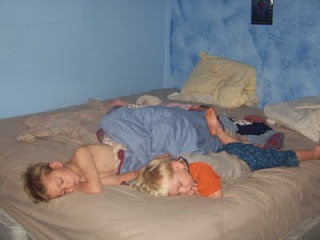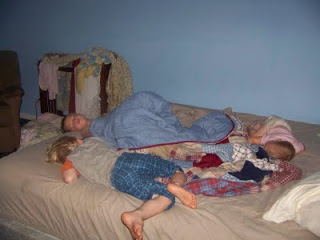 |
| 2009 |
Since I woke up to this precious yet crowded bed a few mornings ago, I have been thinking a lot about co sleeping and how it changes as baby grows.
First is the newborn phase. This is marked by a neat separate area for baby to sleep. Carefully arranged, reduced, or eliminated pillows and blankets. Mom nurses baby and then makes sure everything is neatly rearranged before returning herself to sleep.
Then comes the comfy co sleeper phase. This phase is marked by a larger, yet mostly non mobile baby. Care is still taken with pillows and blankets, but the fear of actually losing baby has almost gone away since baby has grown. Mom still has ultimate authority over breastfeeding positioning and timing. In many ways this is the ultimate period of co sleeping.
Comfortable co sleeping has its end, however, when baby figures out how to move. This next phase can be broken down into several revolving stages. First is the perpendicular sleeper. The lucky parent is the recipient of merely a head in the armpit. The not-so-lucky parent in subjected to continual feet in the rib cage throughout the night.
In addition to the perpendicular sleeper, the newly mobile baby and toddler discovers that mom makes a really good pillow. Or at least a sleeping ledge. Mom finds she often wakes to being in contact with at least 75% of baby’s body. When an older sibling is also involved, this contact phase runs parallel to the sandwich phase. This is when mom wakes up as the peanut butter in between two (in our case gluten free) slices of bread.
The night time nursing relationship takes a hit at some point during the mobile phase. At this point, baby can zero in on target, access the target, and attack the target without any assistance from mom. Some moms are able to sleep through these well planned attacks, but others find their sleep to be significantly disrupted…often waking regularly throughout the night when their little barracuda decides to attack.
The only significant counter measure to this phase is a VERY long nightgown. Possibly tied shut at the bottom.
The above three phases to co sleeping can continue for quite some time, waxing and waning as the child may or may not adjust to sleeping in their own spot in Mom and Dad’s bed or elsewhere. Eventually, however, children move into the negotiation phase of co sleeping. Parents hear themselves saying, “You can sleep here, but no nursing until the sun comes up” or “Other side of Daddy, please,” or “Get off of your sister already!” This is the stage at our house when we start to encourage the floor next to our bed. There are glimmers of hope when the toddler or preschooler involved occasionally stays in their own bed all night.
The final phase of co sleeping is the sneaky co sleeper. This is the co sleeper who doesn’t want to admit he might need Mom or Dad in the middle of the night. He is sure he is too old for that and he knows its *against* the rules. This final phase of co sleeper sneaks into the bed late in the night and stands next to the bed for a few moments figuring out the best place to squeeze himself in. Head towards the bottom, feet towards baby sister seems to be a popular conclusion to this thought process. In this case, Mom and Dad may wake up to have no idea when or where all of these children came from.
 |
| 2009 |
| 2011 (That was Tim’s spot in the middle, not mine!) |

You are lucky you still share the same bed – you and Tim that is. Craig has given up. I always have Josh and either AJ or Anna. Then the other that I don't have sleeps with Jacob. Craig sometimes crams with them, or takes the couch, alone. I am jealous! Maybe I will have to invest in a really long nightgown though. We have a nurser who is oh so attached. Still. And I'm tired. Cute post Heidi!
Cute post! My husband said this morning: "I fell asleep cuddling Emma, and woke up cuddling Emma!" She had actually been moved to her bed in the middle of the night. I woke up sandwiched between 2 girls!
I had to chuckle at the "attacking barracuda" phrase! 🙂